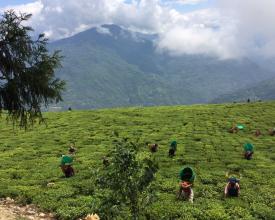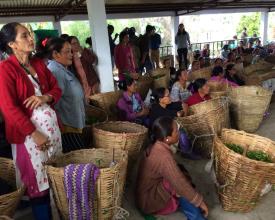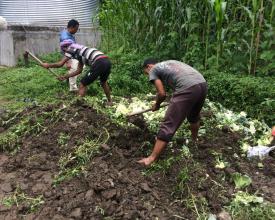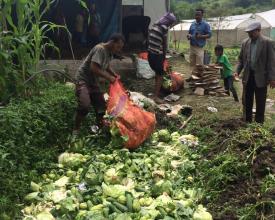
Politique de l'État du Sikkim en matière d'agriculture biologique et mission biologique du Sikkim, Inde
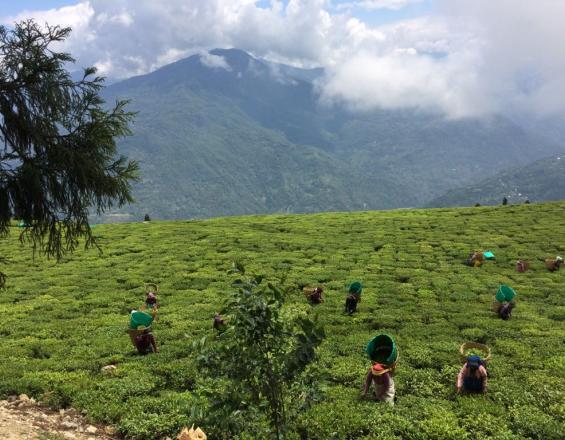
Le Sikkim est le premier État au monde à être 100 % biologique : Toutes ses terres agricoles sont certifiées biologiques. La politique mise en œuvre a consisté à éliminer progressivement les engrais et les pesticides chimiques et à interdire totalement la vente et l'utilisation de pesticides chimiques dans l'État. La transition a bénéficié à plus de 66 000 familles d'agriculteurs.
Parallèlement, l'approche du Sikkim va au-delà de la production biologique et s'est révélée véritablement transformatrice pour l'État et ses citoyens. Les aspects socio-économiques tels que la consommation et l'expansion du marché, les aspects culturels ainsi que la santé, l'éducation, le développement rural et le tourisme durable font partie intégrante de sa conception. Le secteur touristique du Sikkim, par exemple, a grandement bénéficié de la nouvelle image biologique : entre 2014 et 2017, le nombre de touristes a augmenté de plus de 50 %.
Pour leurs réalisations, les politiques du Sikkim ont reçu le Future Policy Gold Award 2018, décerné par le World Future Council en partenariat avec la FAO et IFOAM - Organics International.
Contexte
Défis à relever
Le Sikkim est un petit État himalayen situé dans le nord-est de l'Inde. Il couvre une superficie totale d'environ 709 600 ha et compte quelque 610 577 habitants (recensement de 2011). L'État figure sur la liste des points chauds de la biodiversité mondiale et son écosystème fragile et montagneux nécessite des pratiques agricoles durables pour préserver son capital naturel. Seuls 10 % des terres sont cultivées, le reste étant constitué de forêts, de terres incultivables, de déserts froids et de régions alpines. La topographie de la région ne se prête pas à une agriculture industrielle intensive et l'utilisation de produits chimiques a toujours été relativement faible par rapport à d'autres États indiens. Le Sikkim est donc un État où l'impact de la révolution verte a été marginal. L'engagement politique en faveur de l'agriculture biologique au Sikkim a débuté en 2003. Cette année-là, le ministre en chef du Sikkim, S.E. Pawan Chamling, a annoncé qu'il souhaitait faire du Sikkim le premier État indien à pratiquer l'agriculture biologique et a élaboré un plan d'action.
Emplacement
Traiter
Résumé du processus
Une vision audacieuse d'un État biologique et une feuille de route claire (BB1), ainsi que le pilotage de l'agriculture biologique et le lancement de la mission biologique du Sikkim (BB2) ont été essentiels. Dans un deuxième temps, le gouvernement a associé la stratégie de conversion à l'élimination progressive des intrants synthétiques (BB3). Ensemble, ils ont créé le potentiel d'un modèle transférable (BB4).
Blocs de construction
Développer une vision et une feuille de route claire vers le 100% biologique
Lors du lancement de ces politiques, l'intégration de l'agriculture biologique et agroécologique dans l'ensemble de l'État a été considérée comme une stratégie visant à préserver l'écosystème de l'État et la santé de ses citoyens. Le gouvernement était (et est toujours) convaincu que cette décision apporterait d'énormes avantages socio-économiques, aiderait les jeunes à rester sur leurs terres et attirerait un tourisme durable local et étranger, tout en ouvrant des possibilités d'accéder à des marchés biologiques haut de gamme.
L'engagement politique en faveur de l'agriculture biologique au Sikkim a débuté en 2003. Cette année-là, le ministre en chef du Sikkim, S.E. Pawan Chamling, a annoncé qu'il souhaitait faire du Sikkim le premier État indien à pratiquer l'agriculture biologique. Dans une déclaration historique devant l'assemblée de l'État en 2003, S.E. Chamling a annoncé "une initiative politique attendue depuis longtemps consistant à déclarer le Sikkim comme un État entièrement biologique". La déclaration de 2003 s'est accompagnée de la création d'un plan d'action contenant une série de mesures politiques, notamment l'élimination progressive des intrants synthétiques et le soutien à la production et à l'utilisation d'engrais et de semences biologiques, ainsi que le renforcement des capacités des agents de vulgarisation, des agriculteurs et des jeunes.
Facteurs favorables
En 2003, il n'y avait pas encore d'accord clair sur la manière de progresser vers l'objectif d'un État entièrement biologique. Pour atteindre cet objectif, le gouvernement a élaboré en 2004 une politique opérationnelle et, en août 2010, il a lancé la Sikkim Organic Mission pour mettre en œuvre le plan d'action et les politiques relatives à l'agriculture biologique dans l'État, avec pour objectif de convertir l'ensemble de l'État à l'agriculture biologique d'ici à 2015.
Leçon apprise
La feuille de route qui détaillait clairement toutes les mesures nécessaires pour atteindre l'objectif de devenir un État entièrement biologique d'ici à 2015 était essentielle, tout comme la mise en place de la mission biologique du Sikkim, pour réaliser l'objectif de faire du Sikkim le premier État 100 % biologique au monde. La mission biologique du Sikkim, dont l'objectif est de devenir un État entièrement biologique, est le premier engagement politique aussi clairvoyant et visionnaire pris par un État en Inde, voire dans le monde. En mettant en œuvre cette stratégie politique, le Sikkim montre qu'il prend toutes les mesures nécessaires pour inverser la logique économique dominante qui favorise des formes de production alimentaire ne tenant pas compte des contributions de la nature. Ce plan d'action, ainsi que les politiques qui y sont liées, est unique par son audace. Fait remarquable, il a permis au Sikkim d'atteindre son objectif de convertir l'ensemble de l'État à l'agriculture biologique d'ici décembre 2015. C'est la première fois dans l'histoire qu'un État se fixe une vision aussi ambitieuse et la réalise.
Pilotage de l'agriculture biologique et lancement de la mission biologique du Sikkim
Entre 2003 et 2010, plusieurs programmes pilotes de soutien à l'agriculture biologique ont été lancés, notamment la mise en place de bio-villages où les agriculteurs ont été formés aux pratiques de l'agriculture biologique et à la production d'intrants organiques tels que le compostage, les engrais organiques et les pesticides organiques à partir de plantes locales et d'urine de vache. Au cours de cette période, le gouvernement a également investi de manière substantielle dans la construction de fosses de lombricompostage. En 2009, plus de 100 villages avaient bénéficié de ces programmes, touchant 10 000 agriculteurs dans les quatre districts de l'État.
Dans le cadre de la mission biologique du Sikkim, lancée en 2010, un certain nombre d'actions supplémentaires ont été mises en œuvre pour soutenir l'agriculture biologique, notamment le renforcement des capacités, la production de semences et de matériel de plantation biologiques, la création d'un laboratoire d'analyse des semences et des sols, l'exploitation d'un point de vente au détail de Sikkim Organic à New Delhi, l'inclusion de l'agriculture biologique dans les programmes scolaires, la conversion des deux fermes du gouvernement de l'État à Nazitam et Mellidara, qui sont devenues des centres d'excellence biologiques pour mener des démonstrations et des essais d'agriculture biologique, et le lancement de trois écoles de subsistance en tant que centres de formation pour les jeunes chômeurs.
Facteurs favorables
Les activités visant à fournir aux agriculteurs des semences biologiques de qualité comprenaient le renforcement des installations d'essai et de traitement du laboratoire des semences, et le développement d'une série de projets locaux de développement des semences biologiques, tels que la conclusion de contrats avec des producteurs de semences, l'achat et la distribution par le gouvernement, et la mise en place de serres automatisées pour la production de semis biologiques de qualité.
Leçon apprise
En 2016, un Institut national de recherche sur l'agriculture biologique (NOFRI) a été créé à Gangtok. L'institut encourage la recherche et l'éducation sur l'agriculture biologique et fournit des recherches et un soutien technologique aux systèmes de production biologique, non seulement pour le Sikkim mais aussi pour l'ensemble de la région des collines du nord-est de l'Inde.
La certification a également été un élément essentiel du programme. Quatre-vingt pour cent du budget entre 2010 et 2014 ont été utilisés pour renforcer les capacités des agriculteurs, des prestataires de services ruraux et des organismes de certification en matière de pratiques, d'exigences et d'inspections dans le domaine de l'agriculture biologique, et pour aider les agriculteurs à obtenir la certification, principalement par l'intermédiaire du système de contrôle interne.
Lier la stratégie de conversion à l'élimination progressive des intrants synthétiques
L'un des éléments les plus importants du plan était de coupler la stratégie de conversion avec l'élimination progressive des intrants synthétiques. À partir de 2005, le gouvernement a décidé de ne plus recevoir son quota d'engrais chimiques du gouvernement indien et a commencé à réduire progressivement les subventions sur les engrais chimiques et les pesticides à raison de 10 % par an afin de les rendre plus coûteux et d'en décourager l'achat. Les subventions ont ainsi été progressivement supprimées en 2007-2008. Une autre mesure a consisté à commencer à fermer tous les points de vente et autres points de vente fournissant aux agriculteurs des intrants synthétiques. Le gouvernement de l'État a également commencé à restreindre l'importation d'intrants synthétiques et, finalement, en 2014, le Sikkim Agricultural, Horticultural Inputs and Livestock Feed Regulation Act a été adopté, qui interdit l'importation de tout intrant chimique pour l'agriculture et l'horticulture et, en tant que tel, constitue une interdiction totale de la vente et de l'utilisation de pesticides chimiques dans l'État.
Entre 2010 et 2014, le gouvernement a alloué un budget de 6,75 millions d'euros pour soutenir la mise en œuvre de la mission biologique. Récemment, la mission biologique a également reçu le soutien de programmes du gouvernement central, tels que la mission nationale pour l'agriculture durable (NMSA).
Facteurs favorables
- Le gouvernement de l'État a fait preuve d'une forte volonté politique et d'une grande cohérence, avec des objectifs et des plans de mise en œuvre bien définis, qui peuvent être adoptés par d'autres États.
- La stratégie du gouvernement de l'État visant à éliminer progressivement les engrais chimiques a été mise en œuvre progressivement, mais fermement. Il s'agit d'une décision audacieuse, soutenue par des mesures substantielles visant à mettre en place de véritables alternatives durables.
Leçon apprise
Depuis l'introduction de cette politique, le gouvernement régional et la population en général ont déployé des efforts résolus pour mettre fin à l'utilisation de produits chimiques dans les champs et pour convertir toutes les terres agricoles nationales à des pratiques biologiques. Les mesures comprennent la mise en place de bio-villages, où les agriculteurs sont formés aux pratiques de l'agriculture biologique, et la production d'intrants biologiques à la ferme, tels que le compostage, les engrais et les pesticides biologiques, en utilisant des matières végétales disponibles localement et de l'urine de vache. Les exigences obligatoires ont été combinées à un soutien et à des incitations, et en fournissant des alternatives durables, la mise en œuvre de la stratégie du Sikkim a été couronnée de succès.
Le potentiel d'un modèle transférable
Bien qu'il s'agisse d'un petit État, le leadership visionnaire du Sikkim fait l'objet d'une grande attention en Inde et semble destiné à se répercuter dans le monde entier. Les pays et États voisins manifestent un vif intérêt pour la reproduction de ce modèle et de nombreux autres pays, notamment en Asie, ont invité le Sikkim à échanger ses expériences.
Le Bhoutan a déjà établi une nouvelle feuille de route pour devenir un État 100 % biologique d'ici 2023, et un certain nombre d'États indiens souhaitent maintenant suivre le souhait du Premier ministre indien de voir l'ensemble de l'Inde du Nord se convertir à l'agriculture biologique. Début 2018, l'Uttakarand est devenu le deuxième État indien à promettre un soutien plus large à l'agriculture biologique pour ses 1,6 million d'agriculteurs, en annonçant un plan d'action soutenu par un financement fédéral d'environ 189 millions d'euros pour les trois prochaines années. L'agriculture biologique peut aider l'Inde à atteindre ses propres objectifs de développement durable, notamment en doublant le revenu des agriculteurs ruraux d'ici 2022, si davantage d'États indiens adoptent le modèle d'agriculture biologique du Sikkim.
Facteurs favorables
- L'engagement politique a été déterminant. Le soutien politique du Sikkim à l'agriculture biologique a débuté en 2003 et a été consolidé en 2010 avec la conception de la mission biologique du Sikkim.
- Cohérence et persévérance : L'objectif a été atteint en seulement 12 ans.
Leçon apprise
Il était essentiel de bénéficier d'un soutien politique total et d'élaborer une feuille de route détaillant clairement toutes les mesures nécessaires pour atteindre l'objectif de devenir un État entièrement biologique d'ici à 2015.
Impacts
L'expérience du Sikkim a été largement positive. Tout d'abord, le gouvernement de l'État a fait preuve d'une forte volonté politique et d'une grande cohérence, ainsi que d'objectifs et de plans de mise en œuvre bien définis. La stratégie du gouvernement de l'État visant à éliminer progressivement mais fermement les engrais chimiques a été mise en œuvre, soutenue par des mesures substantielles visant à mettre en place de véritables solutions de remplacement durables. Les agriculteurs et les citoyens sont fiers de cette politique et continuent à lui apporter un soutien politique.
Aujourd'hui, plus de 66 000 familles d'agriculteurs, gérant plus de 76 000 hectares de terres, ont bénéficié de la transition. Ces communautés agricoles ont acquis un bon niveau de compréhension des pratiques de l'agriculture biologique. Pour améliorer la gestion de la santé des sols, le gouvernement a aidé les agriculteurs à réaliser 40 000 analyses de sol par an. En outre, les trois écoles de formation à l'agriculture biologique ont formé 836 chômeurs, dont 695 sont aujourd'hui employés comme superviseurs de terrain.
Parallèlement, l'approche du Sikkim va au-delà de la production biologique et s'est avérée véritablement transformatrice pour l'État et ses citoyens. Les aspects socio-économiques, tels que la consommation et l'expansion du marché, les aspects culturels ainsi que la santé, l'éducation, le développement rural et le tourisme durable font partie intégrante de sa conception. Grâce à l'image biologique du Sikkim, le nombre de touristes a augmenté de plus de 50 % entre 2014 et 2017.
Bénéficiaires
Les principaux bénéficiaires sont les plus de 66 000 familles d'agriculteurs sikkimais, qui gèrent plus de 76 000 hectares de terres. Grâce à la fourniture d'aliments biologiques sains, la politique profite à l'ensemble de la population. Les touristes qui visitent aujourd'hui le Sikkim en bénéficient également.
Objectifs de développement durable
Histoire
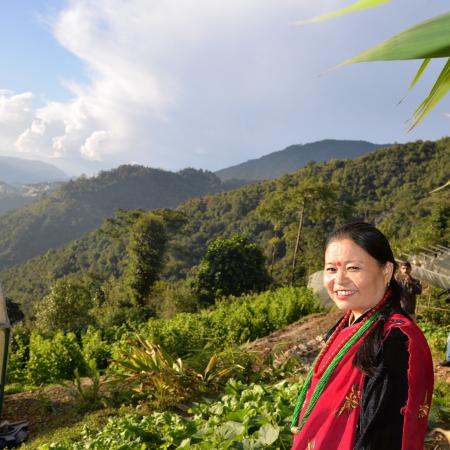
Je vis avec ma famille dans le village de Bul, situé en altitude dans les montagnes du Sikkim, en Inde. Ma famille s'appelle Mala Sherpa. Mon village compte 285 familles qui cultivent des fruits, des légumes et des fleurs. Lorsque des visiteurs viennent à Bul, nous aimons leur préparer une grande fête. Nous les accueillons avec des couronnes de fleurs de souci jaune orangé et des châles de soie colorés, beaucoup de musique, de chants et de danses, et bien sûr une nourriture bonne et saine. Nous aimons proposer des plats à base de pommes de terre, de légumes et de poulet grillé ou de viande de yak, accompagnés de Chang, une sorte de vin léger qui est une boisson très populaire au Sikkim.
Ma famille possède une ferme biologique de démonstration. Trois générations vivent dans notre ferme, ce qui est assez typique du Sikkim. Outre mes grands-parents âgés et mon mari, la jeune génération apporte sa contribution. Nous n'avons pas vraiment de problème de succession familiale, ce qui semble être le cas dans de nombreux autres États de l'Inde. En effet, grâce aux perspectives d'avenir positives pour les exploitations agricoles du Sikkim et au fait que nos parents sont des agriculteurs prospères et fiers de l'être, nos jeunes restent à la campagne et envisagent de devenir agriculteurs à leur tour.
Dans notre ferme, nous avons des vaches et des chèvres. Nos champs en terrasse sont étroits. Pour labourer nos champs avec la petite charrue que nous possédons, mon mari doit être très concentré. Nous sommes très fiers de l'assurance de nos vaches, qui tournent sur place. Nous avons également des tas de compost et des tonneaux contenant des préparations à base de plantes - tout est bien étiqueté, car nous sommes une ferme de démonstration et servons de centre d'apprentissage pour tous les agriculteurs de Bul. Dans nos champs, nous cultivons des pommes de terre, du chou frisé, des carottes, des poireaux, de l'ail, du gingembre et des fleurs. Mais c'est la cardamome, dont le Sikkim est le premier producteur mondial, qui nous rapporte le plus. Personnellement, j'aime beaucoup nos parcelles de fleurs, qui contribuent également de manière significative à nos revenus. Le passage à l'agriculture biologique a été très important pour nous, car il a permis à ma famille de bénéficier d'un bon revenu et d'un avenir sûr. À mon avis, les politiques biologiques du Sikkim devraient être généralisées et étendues à l'Inde et au monde entier.

